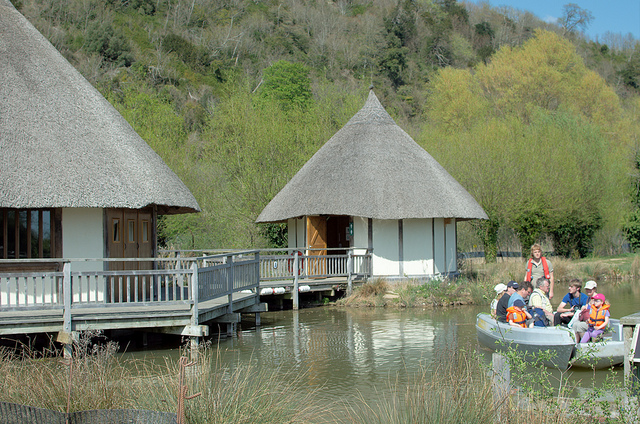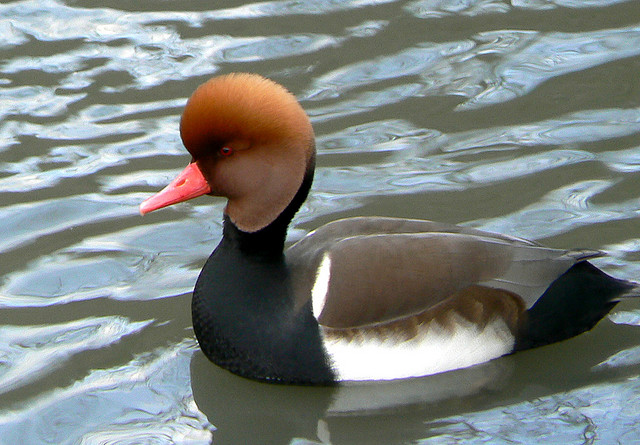Arundel Wildfowl
and Wetlands Centre
West Sussex
|

Location Guide |
This is one of the
Wildfowl and Wetlands Trust's
 site.
It is 26 hectares of naturalised landscape and wetland habitat holding many
hundreds of exotic wildlife from around the world and is home to many rare
species of wetland wildlife, as well as attracting wildlife visitors. It is set in ancient woodlands in the middle of the
South Downs next to the River Arun and overlooked by Arundel Castle. site.
It is 26 hectares of naturalised landscape and wetland habitat holding many
hundreds of exotic wildlife from around the world and is home to many rare
species of wetland wildlife, as well as attracting wildlife visitors. It is set in ancient woodlands in the middle of the
South Downs next to the River Arun and overlooked by Arundel Castle.
Their wetlands discovery area allows you to
take a quiet safari boat ride along the waterways and on your journey discover
the wild flora and fauna in their natural environment and hopefully some wetland
visitors. Boats have a restricted number of persons on board and with a trained guide
you get as close as possible to the wildlife, so no need for telescopes or
binoculars. You travel deep into the reed beds, where you might see Water Voles,
migrant birds, dragonflies, snakes and more. You can also take a reed bed walk
and get up close yourself at your own pace if you want to.
As well as the annual wild visitors which
visit, like all of the WWT centres, they also have some permanent residents on
their lakes such as New Zealand Blue Ducks.
Other exhibits around the reserve include:
-
Pond
Explorer where you can get up close to pond life
-
A reedbed broad walk where you get to
walk through the largest reedbeds in Sussex
-
Reed
Chamber a building containing a camera obscurer giving a different perspective
on the reeds
-
A
thatched building containing an exhibition of a collection of native wild plants
and flowers with descriptions of medicinal and nutritional qualities as taken
from local country lore
-
Round
thatched buildings used to demonstrate sustainable building techniques
-
Hides
over looking the main wetland lakes where you can watch the visiting waterfowl
-
Meadow
Maze Walk and Tree Creepers which allow children in particular a fun way to
learn about wildlife and the little creatures around them.

Round Exhibition Huts and Boat Ride
 Adam
Oxford
Adam
Oxford
RESERVE WILDLIFE REGULARS
Throughout the year on a visit you can expect
to see such highlights as
Kingfishers, Reed Buntings, Goldcrest, Bullfinches, Blackcaps, Siskin, Redpol,
Grey Wagtails, Long-tailed, Marsh, Coal, Great
and Blue Tits, Willow and Sedge Warblers, Cetti's Warblers, Water Voles, Nightingale and a
Cuckoos may be heard and Common Tern. See their website for daily reports of
what can be seen.
A flavour of what you might see on a visit:
Extracted from the
ARUNDEL March 13th 2008 NEWS REPORT
Cettis Warbler
and Reed Bunting are singing in their
territories and the Peregrines on the Hanger have been
observed displaying with the pair mating at the end of the ritual. The
first Mallard ducklings have been hatching over the past
week. Two pairs of Oystercatchers can be seen on the
islands of Swan Lake and the Scrape area. Lapwing are
starting to display with the males tumbling and diving whilst delivering
their lovely 'peewit' call. Snipe have been seen in many
areas of reserve with up to 13 in the cut area of the Reedbed and over 50
individuals being seen from the Ramsar hide. A Firecrest
has been present in the hedgerow opposite the Wildlife Garden. Good
numbers of Pochard and Tufted Duck are
still being seen on Wetlands Discovery and most of them are in pairs.
Blue Tits and Great Tits have been seen
inspecting the numbered woodcrete nest boxes and a pair of
Treecreeper are a regular sighting on the silver birch trees at
the start of the North American pen. Kingfishers
can still be seen around the reserve but not as regularly now that they
have paired and set up their territories. Common Frogs
have spawned in the newly created pools in the cut area of the reedbed. A
couple of Common Toads have been seen in and around the
reserve but have yet to spawn.
Coltsfoot is now flowering well in several areas
especially on Wetlands Discovery and a single Lady's Smock
was seen flowering last week. The Wet Meadow area on the Woodland
loop has now had some work completed to remove some of the spreading
Dogwood and a cut and rake to encourage some of the
delicate flowers which have grown here in the past. |

Red Crested Pochard
 Kate
Kate

OTHER WILDLIFE AND NATURE
HIGHLIGHTS
Also on site if you look closely you should be
able to see butterflies
such as the Peacock, Small
Tortoiseshell, Comma and Brimstone. Clumps of Coltsfoot, Primrose, Cuckoo Flower,
Cowslips, Dog Violet, Hyacinth, Snakeshead Fritillary, Speedwell, Ground Ivy,
Marsh Marigold, Herb Robert and Bluebells flower throughout
the reserve.
How to Get There In Detail
WWT Arundel is close to the A27 & A29. On approaching Arundel by road,
visitors should follow the brown duck signs. By foot from Arundel railway
station, it is half a mile to Arundel Town and a further, gentle mile along Mill
Road to the Trust. By Bus, there is a 30 minute service both from Chichester &
the West (Route 55), and Brighton, Worthing & the East (Route 702) every weekday
to the Arundel Town centre with the same walk along Mill Road.
| Further information Grid
|
Location: |
Arundel
WWT - West Sussex |
|
Ceremonial County: |
Sussex
 |
|
Grid Reference: |
TQ020081 |
|
Map Link: |
StreetMap
 |
|
Aerial photo: |
Google Aerial
 |
|
Route(s):
|
|
|
Best Times to Visit: |
Any
time of year, different times will see different wildlife visitors. More
activities for children available during the summer months and school
holidays. |
|
E-mail: |
info.arundel@wwt.org.uk |
|
Website: |
http://www.wwt.org.uk/visit-us/arundel/
 |
|
Other useful
websites: |
|
|
Nearby Locations: |
|
|
Other Relevant pages: |
|
|
|
.
Planning Grid
|
Location: |
Arundel
WWT - West Sussex |
|
Grid Reference: |
TQ020081 |
|
Getting there: |
WWT Arundel
is close to the A27 & A29. On approaching Arundel by road, follow the brown
duck signs. |
|
Access: |
Level access and hard surfaced tarmac paths. The broadwalk is wooden with
anti-slip netting.
Low level viewing windows and level access in
most hids. |
|
Parking: |
Large free car
park. |
|
Facilities: |
Cafe (serves hot food between 11am and 3pm), gift shop and art gallery.
Picnic area. Talks and tactile exhibits
can be organised by prior arrangement. |
|
Things To Do,
See and Photograph: |
Wetland wildlife, butterflies, wild flowers, buildings, reed beds and other
activities. |
|
What to take: |
telescope, binoculars, long lenses for when in hides, polarizer may be
useful on sunny days when doing wider views. During winter months wrap up
warm most of the site is outdoors. |
|
Nature highlights: |
Waders,
Raptors, Wildfowl, butterflies, dragonflies and wild flowers. |
|
Address: |
WWT Arundel
The Wildfowl & Wetlands Trust
Mill Road
Arundel
West Sussex |
|
Postcode: |
BN18 9PB |
|
Telephone: |
01903 883355 |
|
Opening times: |
Open daily 9.30am
to 4.30pm. Closed Christmas Day |
|
Charges: |
Adult £9.91;
Concession (Students, Over 65 and unemployed) £8.27, Child £4.95 (4-16 years);
Family Ticket (2+2) £26.45
Child (<4) and disabled visitor helpers FREE.
FREE to WWT Members
There are also special Group Admission Prices
and Gift Aid prices. |
|
Photo Restrictions: |
Commercial and stock photography must be agreed in advance and is subject to
a fee. |
|
Other Restrictions: |
Keep to the paths at all times. |
|
Special Needs Access: |
Level access to all areas. Car park has
reserved bays |
|
Special Needs Facilities: |
Disabled toilet in main visitor centre, free
wheelchair loan |
|
Children Facilities: |
During weekends and school holidays activities
are put on for the younger visitor. Baby changing facilities. |
|
Dogs Allowed: |
Dogs are not allowed in WWT Centres except
guide/trained assistant dogs. |
|

|
Please let us know any other information that we
can add to the Further information and Planning Grids or page and any errors that you discover. Before making a long trip to any location it is always
wise to double check the current information, websites like magazines may be
correct at the time the information is written, but things change and it is of
course impossible to double check all entries on a regular basis. If you have
any good photographs that you feel would improve the illustration of this page
then please let us have copies. In referring to this page it is helpful if you
quote both the Page Ref and Topic or Section references from the Grid below. To print the
planning grid select it then right click and print the selected area.
Please submit information on locations you discover so
that this system continues to grow.
|